Ten years ago, I couldn't have cared less if the new burger place downtown had a website. Now, I don't trust one that doesn't. Consumer buying behavior has drastically changed -- today, the majority of consumers are purchasing products online, including almost 70% of millennials.
In 2019, almost two-thirds of businesses (64%) have a website. If you don't have one, you could be falling behind your online competition.
If your business is online, you're a part of the digital transformation. But it's not enough these days to just "be online". Businesses in 2019 that thrive are operating online -- with the aid of different apps, sites, and CRMs to help them out.
So, while it's a great step to have a website and a Facebook page, there's more to the transformation than just that.
Here, we'll explore what the digital transformation is, and how you can get on board to ensure your operations run smoother than ever.
What is the digital transformation?
Digital transformation is simply a term for the shift we're experiencing as a society. As the world becomes increasingly digital, so is the way businesses work. It's not changing what businesses do -- rather, it's just changing which platforms businesses use.
For example, instead of reading a map to find directions to that new burger place, you can simply type the business's name into Google or a Maps app, and retrieve the same information. The only difference is that the information is online.
Finding information online transfers to businesses' recruitment processes, as well. Instead of a prospective employee filling out a paper application in-person, now most companies post applications on LinkedIn or Indeed.
Additionally, customer experiences have become increasingly digital with social media marketing.
Tech-savvy companies nowadays have interactive, beautiful websites. Plus, in 2019, a company's tracking process transfers to online analytics.
The transformation is everywhere, and becoming more commonplace each day.
What does digital transformation mean for you? Well, it's a reminder that any paper materials your company is using in the day-to-day might need a new medium -- the internet.
Next, let's take a look at why the digital transformation is happening, and go over a strategy to make sure your company isn't falling behind when it comes to being online.
Why are businesses experiencing a digital transformation?
Simply put, things are often easier when they're online. Additionally, new technology is making website building more accessible, and creating more opportunities for businesses to connect with their audiences.
In fact, 70% of businesses today are finding that the digital shift is worth it, and these businesses either have a digital strategy in place, or are earnestly working towards one.
A digital shift not only saves you trees, but time.
You may be using some methods of digital strategy already. SOPs, social media campaigns, and instant messaging apps like Slack are all examples of small digital transformations that replace paper instructions, outbound marketing, and an extra trip to your manager's desk.
Other methods of shifting digitally aren't as easy to implement, like social media. However, with 63% of businesses going the social media route with their marketing, the increasing importance of the medium is rapidly becoming prevalent.
Next, let's explore some examples of digital transformation more in-depth, so you can consider implementing some of these processes for your own business.
Digital transformation examples
1. Instant messaging
Instead of having a meeting or a long email thread for a quick message, send it to your company's workspace channel. Some instant messaging services are made for corporate settings, like Slack or Flock.
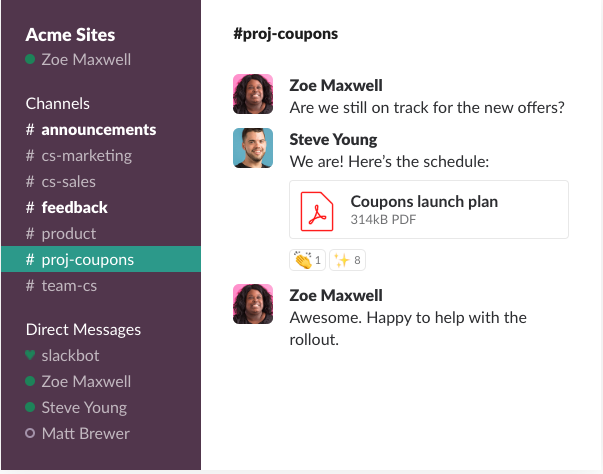
With these services, you can file share, direct message, and create channels where teams can collaborate and discuss projects. Think of it as the office water cooler -- just online.
2. Application tools
Are you looking for new talent? The best candidates (especially ones who prefer to work digitally) are online.
For instance, LinkedIn, a site for professional networking, is a great source for recruiting candidates:
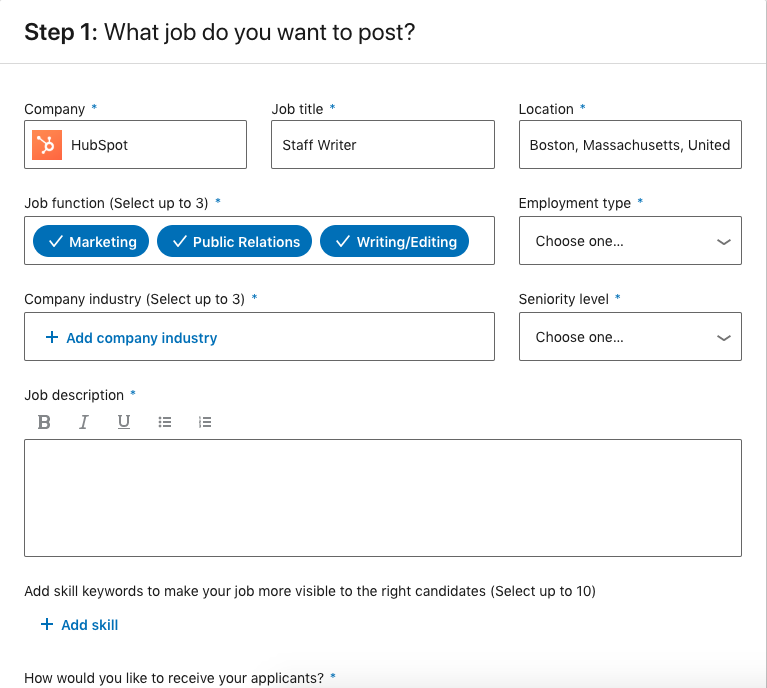
Using LinkedIn's template will help you post an incredible listing, and you can use LinkedIn's industries function to help the right candidates find it. LinkedIn will alert you of new applicants and send you their applications, making the selection process an online breeze.
3. Sales management
As aforementioned, software is available to help manage many facets of your business, including sales. This software helps you manage calls, pipelines, reporting, and follow-up resources to help your process migrate smoothly online.
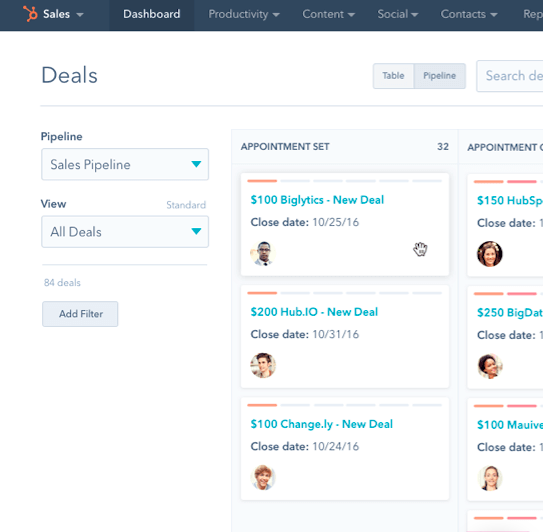
For instance, HubSpot offers a free Sales hub to organize all of your sales materials online. In the tool, you can manage deals, filter contacts, and create different tasks via dashboard to help you keep track of your sales processes.
4. Standard operating procedures (SOPs)
If you have certain aspects of your day-to-day that require multiple steps written down somewhere, dig it out and post it online. This will reduce the paper trail and make the processes shareable among employees.
For instance, this is an example of a standard operating procedure and yes, you can find them online, too:
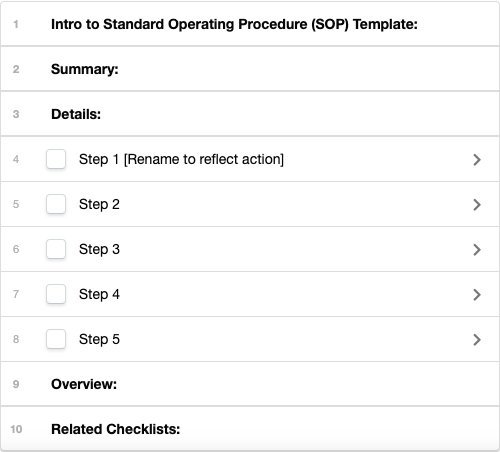
Online SOP software makes listing the procedures of job functions easy to do and comprehend. To help make the transition smooth, talk to your employees and ask them to collaborate with you in the process.
5. Customer relationship management (CRM) software
A CRM is going to be your best friend when shifting to an all-digital business. Our research checklist consolidates the process because it's extensive, but necessary. Ultimately, CRMs help you maintain relationships with customers.
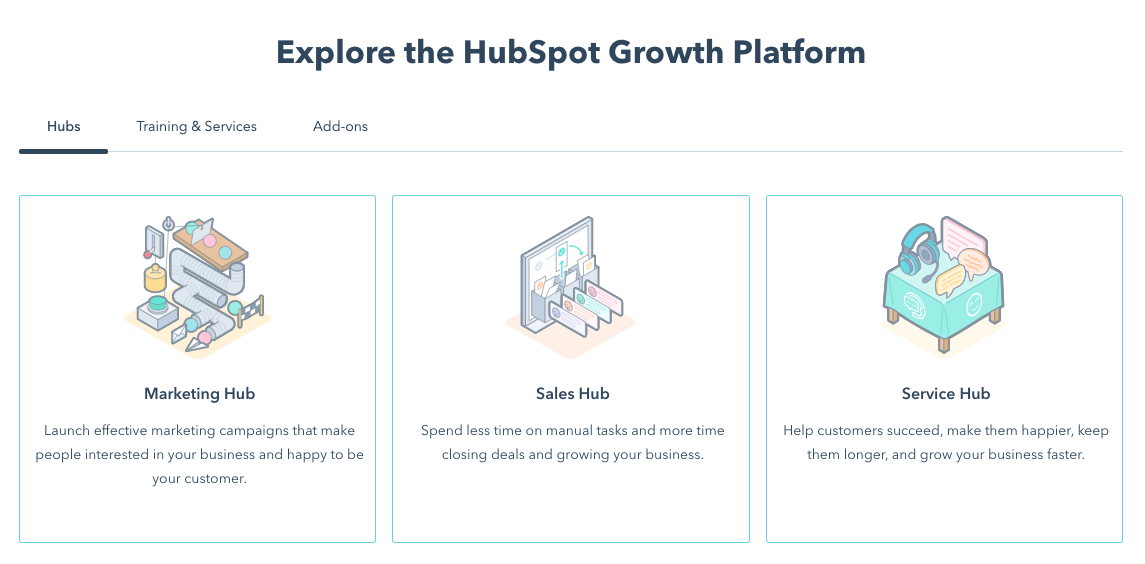
HubSpot's free CRM offers three hubs that give you an all-in-one business platform experience. From customer service reps to sales leaders and business owners, this free CRM helps you fully transfer your business online and drive growth.
6. Video chat software
Is your team out of town but you need to schedule a meeting? Use video chat software to meet virtually. Software like Skype for Business and Zoom offer free web-chatting services for professional use.
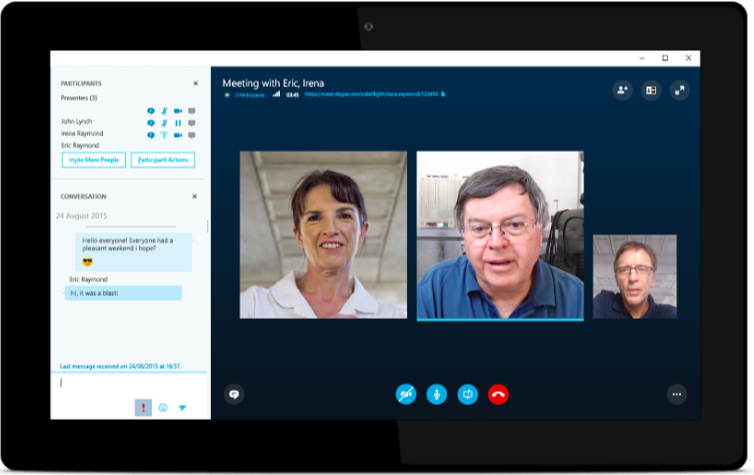
Skype has automatic subtitle settings and 1:1 capabilities as well as the option to host multiple people on calls at once. Most software also has a phone version, to make sure you're accessible anytime, anywhere (during the work day).
Though these tools are designed to make your life easier, every process won't be as seamless as it could be, and digital transformations are no exception. Let's explore some major challenges of shifting to a digital process, next.
Digital Transformation Challenges
Even though the advantages of shifting digitally are abundant, there are challenges in making that transfer happen. Like previously mentioned, two-thirds of small businesses are online. However, that still leaves one-third that are likely hesitant to make the push.
Common challenges to beginning a digital transformation are employee pushback, limited budget, technical difficulties with integration, and poor business models. Each of these challenges come with their own set of solutions.
With a proper strategy, these challenges can be alleviated. For instance, you can work with managers to ensure your employees are informed about the changes that matter to them.
Alternatively, you might start your digital transformation with cheaper components, like social media or a free CRM, rather than more expensive foundational switches like creating high-quality advertising campaigns.
HubSpot offers a free template that will help you schedule and work through a digital transformation process, broken down into seven weeks. Week one is all about gathering existing sales and marketing materials on paper, while week two dives into transferring your business online, and so on. These small steps are designed to fit into your busy schedule and help you remain organized as you transition.
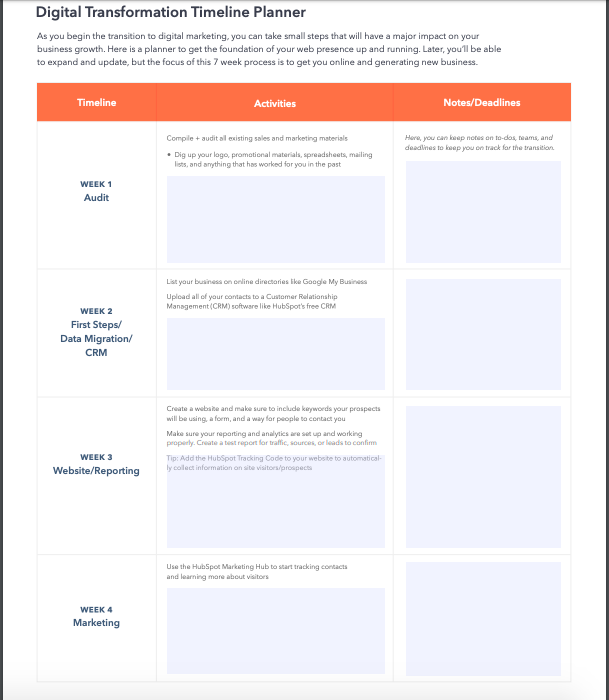
Week two is also the data migration step. A free CRM, like HubSpot, can help you input business data like contacts in one place that's easy to access.
By weeks three and four, you'll have a functioning website and marketing resources to help you learn more about integrating processes online.
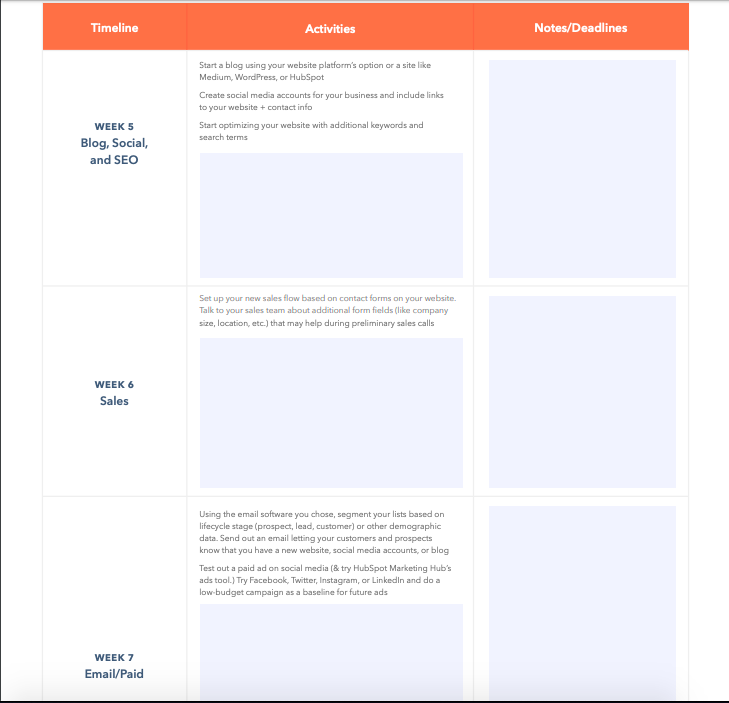
The latter half of the weekly plan ramps up your online presence. Using this template can help you organize your new digital shift by area, to avoid doing one huge push all at once and confusing employees.
Creating a blog during week five will help you find your target audience online. Posts should be about your target market (if you're a tech marketing company, for instance, posts should center around the intersection between the two) to demonstrate your expertise. This will build your reputation as a thought leader in your industry.
Setting up a sales flow by week six will transition your sales process to be completely digital. Online sales tools allow you to keep track of all your contacts, log your conversations, and keep tabs on call schedules and upcoming meetings.
Email and paid ads should be rocking-and-rollin' by week seven. The email software you choose will help you through the process of sending automated emails to subscribers, and let you test out paid ad software.
In a month and a half, most of your business processes will be digital.
Best of all, this template gives you the wiggle room to expand as your business continues to incorporate digital components -- but as a starting point, it gets you up and running. Hopefully with this template, those challenges mentioned above -- like working with hesitant employees, a weak business model, or limited budget -- seem a little less daunting.
Now, I bet you're thinking of a way to start researching. The internet is a vast place, after all. Well, there's a template for that, too. This checklist is part of the set of free templates HubSpot offers that help you filter through different tools and resources to find the one that's right for you.
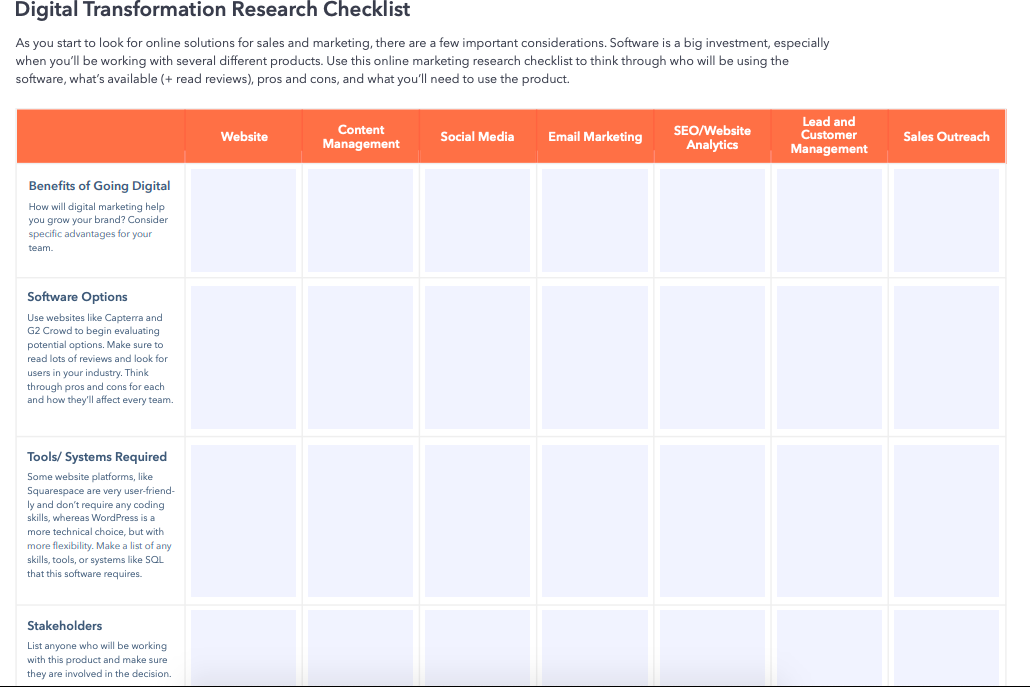
The checklist is made with your business in mind, to think about how restructuring online will benefit you. Additionally, it gives you room to think about the pros and cons of different software out there, including what will likely work best with your operations and budget.
Additionally, you can use these resources to present the benefits of a digital transformation to involved stakeholders. Everyone can have access to this template to keep current on the transformation, so you can all stay on the same page.
Soon, the majority of businesses will conduct at least part of their business online. To make sure you're one of them, it's critical you take part in the digital transformation. Make sure you're well prepared and amping up for the change, now.
No comments:
Post a Comment